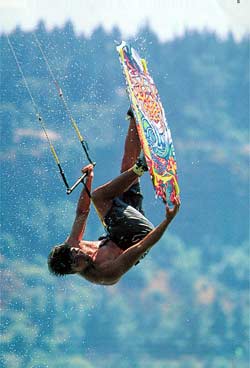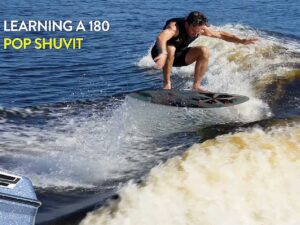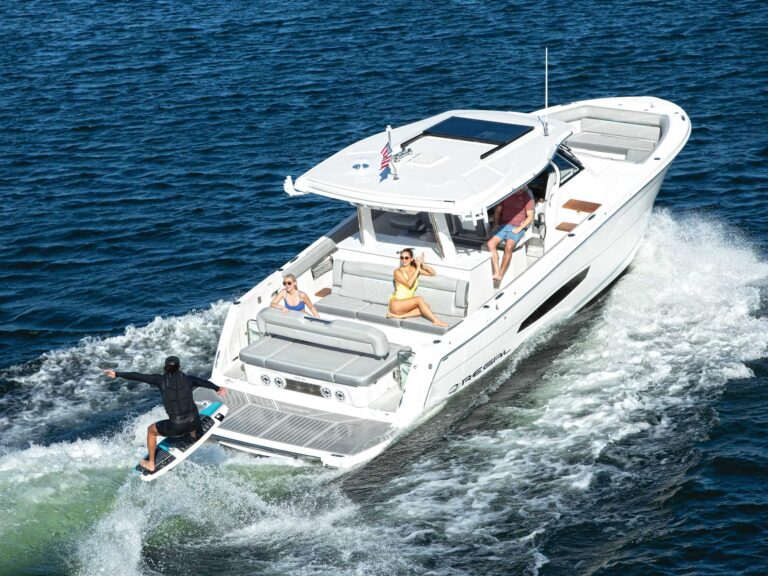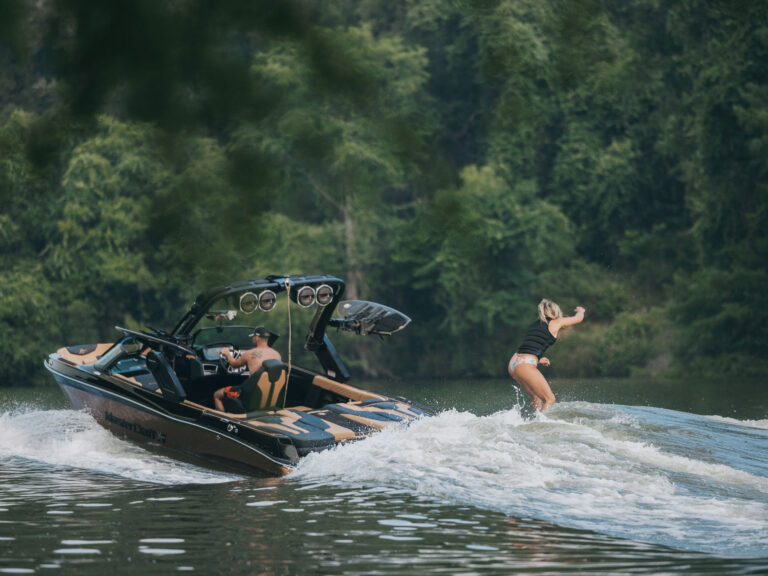I clearly remember my thoughts the first time I saw Lou Wainman launch his board behind a kite. I thought, “That guy is wakeboarding. That guy is getting way more air than any wakeboarder. He doesn’t need a boat!”
It was in Hood River, Oregon — at the world-famously windy Columbia River Gorge. Lou was edging across the river like he was on a hell-cut with a 130-foot line. His kite was knifing across the river some 20 feet over the surface and 100 to his left. But this was no normal kite. It wasn’t pulling him downwind like you would imagine with some normal box kite with a knotted-rag tail. His kite was pulling him, but with Lou edging so hard, he was pulling it, too. Together, they were holding their own upwind! Coming close to the shore, Lou loaded his lines the way Shannon Best loads up before doing an air mobe, then Lou simultaneously popped off the water and cranked his handle to the right. This sent the kite blasting up and to the right, taking Lou with it. In a heartbeat, the kite was a mere speck against the clouds, 150 feet off the ground, and Lou was 130 feet under it midway through a 20-foot melan double back roll. He hung in the air three times longer than Darin’s biggest S-bend and was twice as high. He came out of it, spotted his landing, gently set the board down with no more impact than a simple wake-to-wake jump, and rode away.
Right then, I knew I had to try it.
Your First Try
Of course, it’s not as easy as Lou made it seem. My first sessions were with Lou, the best kiteboarder (on a wakeboard) in the world, and pro windsurfer Elliot Leboe, who is second-best. They were killing it sometimes but getting killed at others. Of course, they’d only been doing it a few months at that point. Kiteboarding on a wakeboard is so new that immediately after my first successful run, Elliot informed me I was probably one of the best in the world (only by default, mind you.) Although kiteboarding is a new sport, there are at least a few hundred guys doing it. But they are primarily on Maui, where it is windy, and primarily riding surfboards with straps because that’s what they’re used to. It took Lou, a wakeboarder from Winter Park, Florida, going to Maui to see the potential of kiteboarding on a wakeboard. He quickly converted Elliot, and once the rest of the Maui crew saw what they were doing, they started to convert as well.
So on my first try, being a wakeboarder, I started on a wakeboard. Even though it’s supposed to be easier on a bigger board like a surfboard or even a dedicated kiteboard being made by some guys, for our purposes a wakeboard is the way.
As I could already tell from some of the situations the boys were getting themselves into, kiteboarding can be really dangerous. You can get dragged across a road, over a jetty, into a dock — anywhere your kite goes, it will take you with it. Anyone who has ever tried it has horror stories. It’s part of joining the kiteboarding fraternity.
On my first try I launched the thing in an open field just to learn to fly the kite. I immediately got lifted up about 10 feet, dragged across the field, pulled out of both my Reefs (forever lost), and pulled across a sidewalk on the tops of my feet; then I pasted some guy on a mountain bike with my kite. He was shrink-wrapped to the pavement by the thing, but at least he stopped it. I thanked him and apologized, then wound up my strings and tried it again. Another time I fell about a mile out to sea off Maui, lost my board and boots, and had to drag (although in a controlled way) myself to the beach. Another time I got overpowered and had to land on the far side of New Smyrna Inlet, then roll my kite up and paddle for a half-hour on my wakeboard back across the most ark-infested spot in Florida to get to my car. I could go on, but you tend to forget all the humbling experiences because when you get it going, it is so good. You see, the beauty and the beast of the kite is that it always wants to launch into the sky. Imagine holding a parachute on the ground on a windy day and you’ll begin to understand the problems. But the first time you get up and realize you control both the throttle of the “boat” and the board, it gives you a sense of freedom you never get with normal wakeboarding.
Kiteboarding isn’t easy, like wakeboarding is, on your first try. You don’t just hold on. But it’s not too hard, either. Assuming you already know how to ride your wakeboard, you simply have to learn to deal with the kite instead of the boat. Learn to fly the kite on the ground, or better yet, at the water’s edge. You’ll want a lot of clear ground downwind. It’s a lot like flying one of those little fighter kites, so if you can do that, you’re ahead of the game. The key to remember is that when you don’t want power, you put the kite straight over your head and hold it steady. When you want power, you dive the kite either to the left or the right. When you’re riding, you’re often diving and climbing the kite simply by moving the “handle” in front of you a couple of inches in or out. It usually takes a subtle but constant working of your arms to produce the up-and-down motion your kite makes as you motor along on edge. If you have a lot of wind, dive your kite once to generate the power to get up, then motor along with your kite hovering about 10 feet off the water.
Still want to know how it works? From the start, have a friend hold the kite while you let out your lines and walk upwind so there is no slack. Put on your board and get in the water, then have your friend toss the kite into the air. Once it’s up, immediately hover it to get under control, then dive it in a direction away from shore. Let’s say you’re in the water with your left foot toward shore, right foot pointing to the middle of the body of water, and wind at your back. You’ll take off regular foot and will immediately take off riding switch (there is no toeside on kiteboarding if you don’t want) with your kite slightly in front of you and to the right about 5 to 30 feet above the water. When you want to change directions, pull in with your left hand and the kite will move like the sun across the sky from your right side to directly overhead (at which point your board will almost start to sink, similar to when the boat makes a very sharp turn-around); then you’ll dive the kite to your left side and be riding regular, virtually on the same track you came out on.
Let’s say you try a little bunny hop and fall. The kite doesn’t know you fell, so it keeps on flying. Now it’s dragging you on your stomach or back, with your arms over your head and your board behind you. You know this feeling — it’s that “I still have the handle so I’ll just tumble out of this” feeling when you are riding behind the boat. But behind a boat, if you can’t get up, the dragging gets old, so you just let go of the handle. You can’t do that with a kite. You don’t want to let go of the handle because your kite will fly away and you may never find it again. So you keep dragging.
When you get good or even just proficient with the kite, you’ll learn to fly the kite into a neutral position right above your head. At this point, the kite kind of hangs there and doesn’t pull you at all. Then you can get your act together and prepare to dive the kite back into its power zone and take off again. Once you are going, you can use your harness to take some of the load off your arms.
What You Need to Get Started
You need a kite, a bar (handle that’s about 2 feet long), two lines that connect the kite to the handle (at least 100 feet each) and a windsurfing harness and harness line. It’s also a good idea to have a webbing leash connected to your board and one of your ankles so you don’t lose your board when you fall.
You also need a leash to go from your handle to your wrist. Even though Elliot told me, “Never let go of the handle,” and I never have, at some point I imagine I will, and if I didn’t have a leash, my kite and bar would be gone. Another safety feature I recommend but I’ve never seen Lou and Elliot use is a quick-release mechanism on one of your lines. This acts like a kill switch to the power of the kite. You release one of the strings and the kite will flail to the ground and not get back up. Be sure the end of what you release is just a loop of line and not some heavy piece of hardware because this thing will be whipping around violently like the butt-end of a rodeo bull. Nothing like getting popped in the head with a brass swivel hook at the end of a 130-foot crack-the-whip.

As for your kite, right now there’s a half-dozen windsurfing sail manufacturers testing their own versions of kites. People are trying to make more efficient, easier to fly kites that have shorter lines, adjustable power, release mechanisms that will depower the kite entirely, and steering ability to make it easier to get upwind. But right now, the only manufacturer who has a kite that’s regularly wakeboarded behind is Wipika. The key to the Wipika kite is the inflated leading edge and stabilizers. This allows the kite to float when it crashes on the water and automatically self-launch. It also allows the kite to be quickly set up by pumping up a couple of small tubes and also folded down into a tiny package the size of a basketball. The Wipika kite is available in three sizes: an 8.5m, a 5.0m and a 3.5m. The more wind you have, the smaller the kite you want.
If you don’t know anything about wind, I’d say just get the 5.0m (say five-oh). Your average blown-out day is about 8 to 10 mph, but you can still easily ride behind your boat at that. When it’s 10-15 mph, you’ll start to see little whitecaps on your lake, and when it’s 15-20 mph, it’s windy. Kiteboarding is more fun when it’s “more windy,” and on your average “damn, it’s windy” day, it’s probably blowing 15 to 20 mph, which is perfect for the 5.0. Rarely does it blow more than 20 unless you live somewhere famous for windsurfing.
Before you call b.s. on kiteboarding, give it a try. Remember the guys who used to put crazy things on their arms and flap around like they could fly? Well, eventually they were called the Wright brothers, and they revolutionized modern society. Of course, realize also that a ton of guys took some serious crashes before they ever had anything that even resembled a plane.es that connect the kite to the handle (at least 100 feet each) and a windsurfing harness and harness line. It’s also a good idea to have a webbing leash connected to your board and one of your ankles so you don’t lose your board when you fall.
You also need a leash to go from your handle to your wrist. Even though Elliot told me, “Never let go of the handle,” and I never have, at some point I imagine I will, and if I didn’t have a leash, my kite and bar would be gone. Another safety feature I recommend but I’ve never seen Lou and Elliot use is a quick-release mechanism on one of your lines. This acts like a kill switch to the power of the kite. You release one of the strings and the kite will flail to the ground and not get back up. Be sure the end of what you release is just a loop of line and not some heavy piece of hardware because this thing will be whipping around violently like the butt-end of a rodeo bull. Nothing like getting popped in the head with a brass swivel hook at the end of a 130-foot crack-the-whip.







